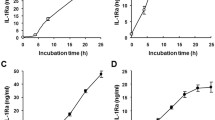Abstract
Background
The anti-tumor agent, Taxol, has been shown in murine macrophages to stimulate tumor necrosis factor (TNF), modulate TNF receptors, induce a large panel of immediate-early genes, and induce protein tyrosine phosphorylation indistinguishably from LPS. These data, coupled with the finding that lipid A antagonists block Taxol-induced stimulation, support the hypothesis that these two structurally unrelated compounds activate a common, receptor-associated signaling apparatus. A very early event in LPS signaling of human monocytes is activation of lyn kinase activity. We therefore sought to evaluate the activation of lyn kinase by LPS and Taxol in LPS-responsive (Lpsn) and LPS-hyporesponsive (Lpsd) macrophages.
Materials and Methods
C3H/OuJ (Lpsn) and C3H/HeJ (Lpsd) macrophages were stimulated by LPS or Taxol. Cell lysates were subjected to immunoprecipitation with anti-lyn antibody, gel electrophoresis, and in vitro kinase assays. Autoradiography and Phosphor-Imager analysis were carried out to detect incorporation of 32P into lyn protein.
Results
Within seconds of stimulation, LPS and Taxol induce in Lpsn macrophages a depression of autophosphorylation, followed within minutes by autophosphorylation of both p53 and p56 lyn species. Lpsd macrophages respond to LPS and Taxol with the initial decrease in activity, but fail to respond to LPS with autophosphorylation, and respond only to a limited extent upon Taxol stimulation. Tyrosine phosphatase inhibitors exerted inhibitory effects on LPS stimulation of lyn autophosphorylation.
Conclusions
Decreased lyn kinase activity within seconds and autophosphorylation within minutes of LPS or Taxol stimulation in Lpsn macrophages strongly supports the hypothesis that LPS and Taxol share a common signaling pathway. The finding that C3H/HeJ macrophages respond to LPS and Taxol with a normal depression of lyn activity, but fail to autophosphorylate lyn normally in response to LPS or Taxol, suggests that the Lpsd defect is distal to LPS-receptor interaction. Finally, the inhibitory effect of tyrosine phosphatase inhibitors on LPS-induced lyn autophosphorylation suggests that tyrosine phosphatase(s) may participate in the regulation of lyn kinase activity.






Similar content being viewed by others
References
(1991) Physician’s Desk Reference. Medical Economics Data, Montvale, NJ.
Nightingale S. (1994) Paclitaxel approved for treatment of certain breast cancer patients. J.A.M.A. 271: 1818.
Rowinsky EK, Donehower RC, Jones RJ, Tucker RW. (1988) Microtubule changes and cytotoxicity in leukemic cell lines treated with taxol. Cancer Res. 48: 4093–4099.
Ding AH, Porteu F, Sanchez E, Nathan CF. (1990) Shared actions of endotoxin and taxol on TNF receptors and TNF release. Science 248: 370–372.
Carboni JM, Singh C, Tepper MA. (1993) Taxol and lipopolysaccharide activation of a murine macrophage cell line and induction of similar tyrosine phosphoproteins. Monogr. Natl. Cancer Inst. 15: 95–101.
Manthey CL, Brandes ME, Perera P-Y, Vogel SN. (1992) Taxol increases steady-state levels of lipopolysaccharide-inducible genes and protein-tyrosine phosphorylation in murine macrophages. J. Immunol. 149: 2459–2465.
Manthey CL, Qureshi N, Stütz PL, Vogel SN. (1993) Lipopolysaccharide antagonists block taxol-induced signaling in murine macrophages. J. Exp. Med. 178: 695–701.
Manthey CL, Perera P-Y, Salkowski CA, Vogel SN. (1994) Taxol provides a second signal for murine macrophage tumoricidal activity. J. Immunol 152: 825–831.
Vogel SN. (1992) The Lps gene: Insights into the genetic and molecular basis of LPS responsiveness and macrophage differentiation. In: Beutler B (ed). Tumor Necrosis Factors: The Molecules and Their Emerging Role in Medicine. Raven Press, New York, pp. 485–513.
Stefanova I, Corcoran ML, Horak EM, Wahl LM, Bolen JB, Horak ID. (1993) Lipopolysaccharide induces activation of CD14-associates protein tyrosine kinase p53/56lyn. J. Biol. Chem. 268: 20725–20728.
Henricson BE, Manthey CL, Perera P-Y, Hamilton TA, Vogel SN. (1993) Dissociation of lipopolysaccharide (LPS)-inducible gene expression in murine macrophages pretreated with smooth LPS versus monophosphoryl lipid A. Infect. Immun. 61: 2325–2333.
Mclntire FC, Sievert HW, Barlow GH, Finley RA, Lee WY. (1967) Chemical physical and biological properties of a lipopolysaccharide from Escherichia coli K235. Biochemistry 6: 2363–2372.
Burkhardt AL, Bolen JB. (1993) Immune-complex assays for tyrosine protein kinases. In: Coligan JE, Kruisbeek AM, Margulies DH, Shevach EM, Strober W. eds. Current Protocols in Immunology. Greene Publishing Associates and Wiley-Interscience, New York, pp. 11.4.1–11.4.8.
Resh M. (1994) Myristylation and palmitylation of src family members: The fats of the matter. Cell 76: 411–413.
Cooper JA, Howell B. (1993) The when and how of src regulation. Cell 73: 1051–1054.
Hailman E, Lichenstein HS, Wurfel MM, et al. (1994) Lipopolysaccharide (LPS)-binding protein accelerates the binding of LPS to CD 14. J. Exp. Med. 179: 269–277.
Weinstein SL, June CH, DeFranco AL. (1993) Lipopolysaccharide-induced protein tyrosine phosphorylation in human macrophages is mediated by CD 14. J. Immunol. 151: 3829–3838.
Jacobavits A, Sharon N, Zan-Bar I. (1982) Acquisition of mitogenic responsiveness by non-responding lymphocytes upon insertion of appropriate membrane components. J. Exp. Med. 156: 1274–1279.
Geppert TD, Whitehurst CE, Thompson P, Beutler B. (1994) Lipopolysaccharide signals activation of tumor necrosis factor biosynthesis through the Ras/Raf-1/MEK/MAPK pathway. Mol. Med. 1: 93–103.
Girault J-A. (1994) Protein kinases and phosphatases. Neurotransmissions 10: 1–6.
Acknowledgements
This work was supported by National Institutes of Health Grant AI-18797 (SNV). The opinions or assertions contained within are the private views of the authors and should not be construed as official or necessarily reflecting the views of USUHS or the Department of Defense. The experiments reported herein were conducted according to the principles set forth in the Guide for the Care and Use of Laboratory Animals, Institute of Laboratory Animal Resources, National Research Council DHEW Publication No. (NIH) 85-23. The authors are extremely thankful to Dr. Joseph Bolen for his very thoughtful discussions and critical review of this manuscript and the Drug Synthesis and Chemistry Branch, Developmental Therapeutics Program, Division of Cancer Treatment, National Cancer Institute, Bethesda, MD, U.S.A., for Taxol.
Author information
Authors and Affiliations
Rights and permissions
About this article
Cite this article
Henricson, B.E., Carboni, J.M., Burkhardt, A.L. et al. LPS and Taxol Activate Lyn Kinase Autophosphorylation in Lpsn, but Not in Lpsd, Macrophages. Mol Med 1, 428–435 (1995). https://doi.org/10.1007/BF03401580
Published:
Issue Date:
DOI: https://doi.org/10.1007/BF03401580




